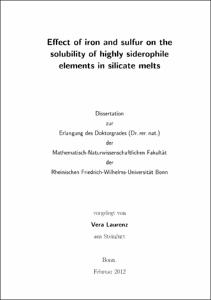Effect of iron and sulfur on the solubility of highly siderophile elements in silicate melts

Effect of iron and sulfur on the solubility of highly siderophile elements in silicate melts

| dc.contributor.advisor | Ballhaus, Christian | |
| dc.contributor.author | Laurenz, Vera | |
| dc.date.accessioned | 2020-04-17T23:00:47Z | |
| dc.date.available | 2020-04-17T23:00:47Z | |
| dc.date.issued | 13.07.2012 | |
| dc.identifier.uri | https://hdl.handle.net/20.500.11811/5330 | |
| dc.description.abstract | An important aspect in highly siderophile element (HSE - Os, Ir, Ru, Rh, Pt, Pd, Re, Au) geochemistry is their solubility in silicate melts. Knowing the solubility of HSE in silicate melts can potentially give insights on whether mantle sources can be metal saturated, as well as provide important constraints on how HSE are enriched in magmatic sulfides. To date, experimentally determined HSE solubilities in silicate melt are mostly available for synthetic melt compositions in the CaO-MgO-Al2O3-SiO2 (CMAS) system. The most striking difference between the CMAS system and natural basaltic melts is the absence of Fe-oxides and S. Therefore, in this dissertation the effects of Fe-oxides and S2- on HSE solubility in silicate melts are investigated. The results of experiments are reported, where a natural picrite was equilibrated with Ru or Pd metal at 1300°C in a one atm vertical gas mixing furnace under controlled oxygen and sulfur partial pressures (fO2 and fS2, respectively). Results show that Pd solubility in silicate melt is influenced by a redox exchange with Fe-oxides. Below FMQ (fayalite-magnetite-quatz buffer) Pd dissolves as univalent species in silicate melts. Above FMQ ferric Fe to promotes the formation of Pd2+, elevating its solubiltiy in silicate melts above that established for Fe-free CMAS melts. Overall, Ru solubility in silicate melts is significantly smaller than the solubility of Pd, Ruthenium does not show a change in oxidation state, uniformly dissolving as Ru4+ in silicate melt above FMQ. When S2- is present as a ligand in addition to O2-, the solubility of Ru in the picritic melt is enhanced more than one order of magnitude in sulfur-bearing experiments relative to S-free melts at identical fO2. These results demonstrate that Ru, and possibly other HSE as well, bond with S2- anions, and dissolve as HSE-S species in a silicate melt in addition to their oxide species. Using the Fe3+/ SFe ratio in the silicate melt to quantify the oxygen available to associate with Ru, the preference of Ru to associate with S2- is calculated to be ~900 times larger than to associate with O2-. This simple estimate clearly shows that sulfur has the major control on Ru solubility in silicate melts, and possibly on the solubilities of other HSE as well. The presence of Fe-oxides as well as sulfur in silicate melts have proven to be important melt compositional parameters, and should be investigated in future experimental studies. A clear implication of these results is that they provide a mechanism for the enrichment of HSE from a silicate melt into a sulfide liquid. All metal-S molecules including RuS2 present in the silicate melt are directly sequestered into an exsolving sulfide melt at the onset of sulfide saturation. This mechanism produces a sulfide liquid that is highly enriched in Ru and other HSE as soon as sulfide liquid is present, precluding the need for complex mixing scenarios. | en |
| dc.language.iso | eng | |
| dc.rights | In Copyright | |
| dc.rights.uri | http://rightsstatements.org/vocab/InC/1.0/ | |
| dc.subject | 1-atm-Experimente | |
| dc.subject | Platingruppenelemente | |
| dc.subject | LA-ICP-MS | |
| dc.subject | Schmelzzusammensetzung | |
| dc.subject | Sulfidlagerstätten | |
| dc.subject | 1 atm experiments | |
| dc.subject | platinum-group elements | |
| dc.subject | melt composition | |
| dc.subject | sulfide ore deposits | |
| dc.subject.ddc | 550 Geowissenschaften | |
| dc.title | Effect of iron and sulfur on the solubility of highly siderophile elements in silicate melts | |
| dc.type | Dissertation oder Habilitation | |
| dc.publisher.name | Universitäts- und Landesbibliothek Bonn | |
| dc.publisher.location | Bonn | |
| dc.rights.accessRights | openAccess | |
| dc.identifier.urn | https://nbn-resolving.org/urn:nbn:de:hbz:5n-28999 | |
| ulbbn.pubtype | Erstveröffentlichung | |
| ulbbnediss.affiliation.name | Rheinische Friedrich-Wilhelms-Universität Bonn | |
| ulbbnediss.affiliation.location | Bonn | |
| ulbbnediss.thesis.level | Dissertation | |
| ulbbnediss.dissID | 2899 | |
| ulbbnediss.date.accepted | 04.05.2012 | |
| ulbbnediss.fakultaet | Mathematisch-Naturwissenschaftliche Fakultät | |
| dc.contributor.coReferee | Geisler-Wierwille, Thorsten |
Files in this item
This item appears in the following Collection(s)
-
E-Dissertationen (4465)




